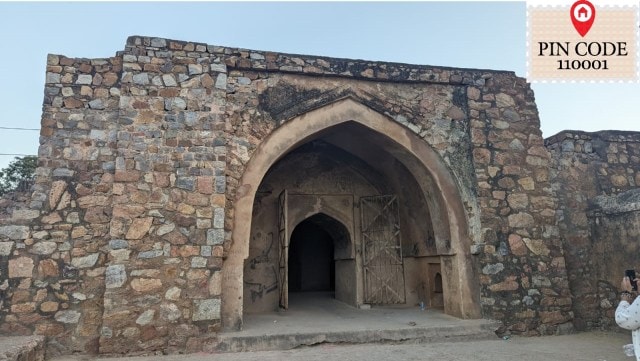Built to supply water, act as bastion, this 14th-century dam still stands strong
Built in 1340 by Mohammad Bin Tughlaq, the dam served two purposes: Providing a reliable source of water for irrigation, and acting as a defence against possible intruders.
 According to Dehlvi, the structure, built using Delhi quartz — a stone found in the Aravallis, is a testament to the superior masonry and architectural skills that marked the Tughlaq era. (Express photo by Deepika Singh)
According to Dehlvi, the structure, built using Delhi quartz — a stone found in the Aravallis, is a testament to the superior masonry and architectural skills that marked the Tughlaq era. (Express photo by Deepika Singh)As one walks out of the labyrinth of Khirki village, home to the majestic Khirki Masjid, a short distance away, an easy-to-miss sign towards the left announces: Satpula. Entering the complex, one is greeted with an arched gate leading to a magnificent Tughlaq-era dam.
Built in 1340 by Mohammad Bin Tughlaq, the dam served two purposes: Providing a reliable source of water for irrigation, and acting as a defence against possible intruders.
Centuries later, the stream over which the dam was built was diverted by the British, reducing the water body to a mere drain flowing on one side. However, the Satpula structure remains formidable as ever, reminding one of the type of masonry the empire was capable of.
According to Author and Historian Swapna Liddle, the dam got its name from the seven arches through which water used to flow from a canal originating from the Aravallis. “It also served as a boundary wall for Jahapanah — the fourth city of Delhi. Like any empire, this one too faced several threats, including from the Mongols. So, apart from serving efficiently as a dam, this structure also acted as a bastion to keep the enemies at bay. Notice the slits on the top part of the construction: These served as a surveillance point for guards for possible intruders whom they could promptly neutralise,” she told The Indian Express.
The dam finds mention in Sir Sayyid Ahmad Khan’s Asar-us-Sanadid (The Remnant Signs of Ancient Heroes) — considered among the first books describing Delhi’s numerous monuments in vivid detail. “In the middle of this [bridge] wall is a huge channel [nala], into which all the water from the channels in Qutub Sahib’s area [Mehrauli] flows. Arches have been built in the wall to ensure easy flow, which is why it is known as the ‘Satpula’ [seven-arched bridge],” Khan, a reformer and educationist, wrote in the book first published in 1847 in Urdu.
 The dam was built by Mohammad Bin Tughlaq in 1340. It also served as a boundary wall for Jahapanah — the fourth city of Delhi. (Express Photo by Deepika Singh)
The dam was built by Mohammad Bin Tughlaq in 1340. It also served as a boundary wall for Jahapanah — the fourth city of Delhi. (Express Photo by Deepika Singh)
Describing how the dam worked, Zafar Hasan, who was associated with the ASI, wrote in his book Monuments of Delhi: “The side walls of these arched openings are grooved for sliding gates, with which the force of the stream flowing from the south through the openings could be regulated.”
According to Liddle, the dam is also considered to have spiritual value. “Since Sufi saint Nasiruddin Mahmud (popularly known as Chirag Dehlavi) used to live nearby, people used to believe that the canal water had healing properties. For centuries, the area used to host a Diwali mela and the attendees would take a holy dip in the waters and even collect some to take home,” she adds.
For Asif Khan Dehlvi, who regularly conducts heritage walks in Delhi through his community Delhi Karavan, the dam was a no-go zone in his growing up years. “I grew up in Delhi, only a few kilometres away from Satpula. Around that time, in the 90s, this area was completely desolate. The Saket malls and Max Hospital that you see now were not there. The dam too was hidden behind bushes and our elders used to advice against visiting it, since it used to serve as a den for criminal elements and was even considered haunted. It is only in the last few years that the structure has regained its glory to some extent,” he tells The Indian Express.
In her book 14 Historic Walks of Delhi, Liddle writes that the rooms in the bastions were for some time also used as a school, giving the building an alternative name — the Madarsa. “By the earlier twentieth century, the Archaeological Survey of India (ASI) took it upon itself to conserve the building, at which time probably the local ritual practices and social functions associated with this building were stopped.”
According to Dehlvi, the structure, built using Delhi quartz — a stone found in the Aravallis, is a testament to the superior masonry and architectural skills that marked the Tughlaq era.
“Just imagine the scene all those centuries ago, when a stream all the way from Aravalli used to flow by the side of the area that now houses the Saket court and make its way here at the dam… What is truly marvellous is that this place is neither a mosque nor a tomb but still has a unique, spiritual character to it. One feels enveloped by a sense of calm here despite being in the chaotic Delhi of today. How many places give you that feeling?”







